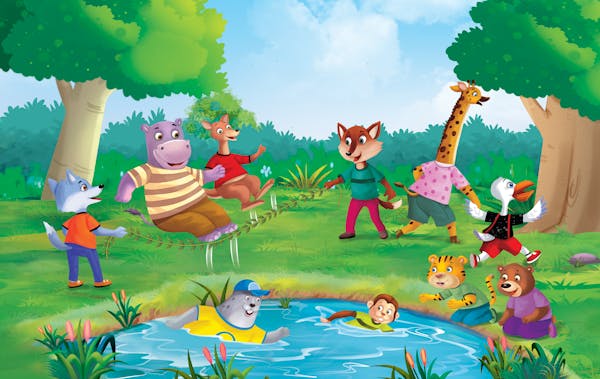A Coon Rapids firm has made a donation that is literally one for the ages.
The Heritage Edition of the St. John's Bible is a printed reproduction of the famous seven-volume work considered the first handwritten, illustrated and illuminated Bible made since the invention of the printing press in the 15th century.
But if "reproduction" conjures an image of a large, beautiful coffee-table book with dazzling full-color illustrations, think again.
Large, beautiful coffee-table reproductions of the original St. John's Bible exist in currently limitless supply; they're called the trade edition and are 15 inches tall. You can buy a hardcover set for $600.
The Heritage Edition is 2 feet tall. It consists of 299 numbered sets. And that's it forever — no more will be made. If you want to buy a set, you'll have to spend $185,000.
Comparing the Heritage Edition to the coffee-table trade edition is like "the difference between a Learjet on a runway with a paper airplane sitting next to it," said the Rev. John F. Ross, executive director of the St. John's Bible Heritage Program at St. John's University in Collegeville, Minn.
"It's a book for the world," Ross said. "Our mission is to ignite the spiritual imagination of people around the world of all faith journeys."
The John Roberts Co., a Coon Rapids printing firm that created the Heritage Edition between 2007 and 2011, recently donated a copy to the Catholic Community of St. Odilia, in Shoreview. The late Bob Keene Sr., who co-founded John Roberts, was a member of the parish.
"it's an amazing, tremendous gift," said the Rev. Erich Rutten of St. Odilia's, when officials of the printing company presented church officials with the rare books last month.
"We're stewards," Rutten said of the parish's plans to display the book. "We will make a home for it, but really it's for the community."
State-of-the-art technology
The original handmade version of the St. John's Bible was commissioned in 1998 by the Benedictine monks at St. John's Abbey and University to mark the turning of the millennium. The project was completed in 2011, its more than 1,100 pages designed under the direction of Donald Jackson, official scribe and calligrapher for the British royal family.
Its words are written in the ancient manner, by an international team of renowned calligraphers and illustrators using goose-quill pens on polished calfskin called vellum. Benedictine scholars picked out passages to be "illuminated" with elaborate lettering and gold-accented images.
"Much is written on the original, but little is out there, frankly, about the reproduction," said Mike Nordberg, senior account executive at John Roberts, who worked extensively on the Heritage Edition.
The John Roberts reproduction is a high achievement in its own right. While the original carefully adhered to ancient techniques, the Heritage Edition — begun in 2007 and was completed in 2011, the same year as the handmade original — was made possible by state-ot-the-art printing technology.
"It's the largest project we've ever done," Nordberg said. "I am humbled to be part of it."
The Heritage Edition is printed on expensive archival 100% cotton paper with a weight and feel similar to vellum, handbound with a single piece of red Italian calfskin leather with a solid silver clasp. The materials are expected to last for generations.
The calligraphy and illustrations are not the shiny four-color combination used in coffee-table-style books, stunning as those often are. The Heritage pages were printed in an ultraviolet process that let the fade-resistant, jewel-toned ink adhere to cotton paper without smudging or spreading. Gold and silver foil, representing the divine, were applied in the form of pictures, letters, neat patterns and abstract shapes.
"The dyes, the foils, the plates, all the things that made up this particular project, it's never going to be done again," Nordberg said.
The Heritage even reproduces some of the original's inadvertent details, such as places where ink from an illustration on the previous page appears to soak through the page.
"You can see the follicles of the calfskin," Nordberg said. "The bleeding of the calfskin from one side to the back side."
Modern touches
Modern audiences — bombarded every day with thousands of images and words in familiar, easily readable standardized fonts — might be as awestruck gazing at an illuminated Bible as their 15th-century counterparts, who never saw printed texts and typically were illiterate.
"You can't skim or go fast-forward on calligraphy," Nordberg said. "In its own beauty it makes you stop and think about what you're reading."
However, the new Bible contains some touches the ancients wouldn't recognize: images of the Twin Towers of the World Trade Center, of modern tanks and oil rigs, of the double-helix shape of a DNA strand. Some of the illustration styles look distinctly modern.
Unlike most traditional Bibles, women are prominently represented, Nordberg said. "The Book of Wisdom is absolutely amazing. It's this really feminine art in pastels and whatnot ... It's gorgeous."
Just over half of the printed books have been acquired, Ross said. Many are in churches or major institutions — the University of Minnesota, the University of St. Thomas, the Mayo Clinic. Locations range from a generous handful in Minnesota to London and Sydney, Australia. Two are at the Vatican.
"I'd say 90% of them were paid for by individuals," Ross said. "A family would buy it and they'd give it straight to their church," or keep it for a while, then donate it to a favorite institution.
Rutten said he's looking forward to making the books accessible to the community "so we can translate God's love in a powerful way." Various institutions that possess the books find their own ways to share them with the public.
"If this doesn't bring glory to God," Nordberg said, "I don't know what does."




